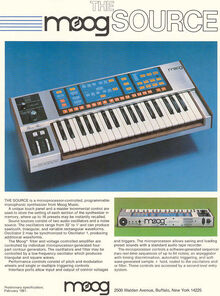
Moog "The Source" advertising flyer, from the Moog Archives.
A monophonic analog synth introduced by Moog Music in 1980. It constitutes several firsts and lasts in Moog History:
- It was the last monophonic synth, and the last synth deriving from the early-1970s Minimoog design, introduced by the original Moog Music.
- It was the first microprocessor-controlled synth in Moog history, and it served as a technology pathfinder for the development of the Memorymoog.
- It was the first Moog synth to have patch memory and a one-knob interface.
- It was also the first Moog synth to have an onboard sequencer and arpeggiator.
The Source (it was first marketed as "The Source", and then later simply "Source") was Moog's attempt to bring the classic Minimoog design into the 1980s. Its voice architecture contained two voltage controlled oscillators and a dedicated low frequency oscillator, a standard Moog four-pole transistor ladder voltage controlled filter, a voltage controlled amplifier, a noise generator (which produced only pink noise), and two ADSR envelope generators (as opposed to the three-segment envelopes typical of Moog products of the era), one dedicated to the VCA and one for the VCF. The VCOs could be synced, and it was possible to detune VCO 2 and vary its scaling.
The user interface consisted of a membrane panel for selecting patches and parameters to be edited, and a rotary encoder used to edit a selected parameter. The membrane panel contained buttons for patch selection (the memory held 16 patches, which was fairly generous for 1980), controlling the sequencer and arpeggiator, and selecting patch parameters to be edited. The colorful panel laid out the primary parameters in a schematic arrangement; pressing a membrane button allowed that parameter to be altered via the rotary encoder. A Page 2 function mapped additional, less used parameters onto some of the buttons; this was indicated by a differently colored legend text above the button.
A three-octave keyboard was paired with conventional pitch and mod wheel performance controls. Above the wheels were a pair of octave shift buttons. The keyboard had C as its lowest note, as opposed to F which was (and still is) more typical of Moog products. Control was via a Zilog Z80, an 8-bit CPU derived from the then-popular Intel 8080. Signal paths were analog, however, including the LFO and envelopes. (A myth persists that the envelopes were generated by the processor, but they were in fact analog.) The unit had a cassette interface for patch storage and retrieval, and CV/gate inputs and outputs.
Two versions of the Source were produced. The second version, introduced during the production run in 1982, had several I/O improvements. On the original, the jack for the cassette interface was a DIN jack. Home audio manufacturers had in the late 1970s tried to establish a five-pin DIN connector to convey the record and playback signals to a cassette deck. It caught on in Europe, but not in the U.S. or Japan, which meant that users in those countries had to find an adapter cable to convert the interface to RCA jacks for connection to their cassette deck. The second version replaced this with conventional 1/4" phone jacks. The DIN connector that had been used for the cassette interface was re-purposed to become an interface for a DIN sync input, which became an option for clocking the sequencer and arpeggiator. (On the original version, the internal LFO was the only clocking option.) A field upgrade kit was produced to upgrade the earlier version units.
Moog sold about 7000 Sources until 1985, when it ended all synth production. Today, the Source has moderate value among collectors. Surprisingly, the membrane panel has held up well on most units, and overall the synth seems to be fairly trouble free; a need to replace a crackly master volume pot is the most often cited issue. A wide variety of mods are available, including an extensive upgrade package from Encore Electronics which contains re-written firmware and adds a full-featured MIDI interface, increases patch storage to 256 slots, and adds some options for VCO routing and modulation. Curiously, some collectors name the Source as the Minimoog-derived model that sounds the most like the Minimoog, while others maintain that it doesn't sound like the Minimoog at all.